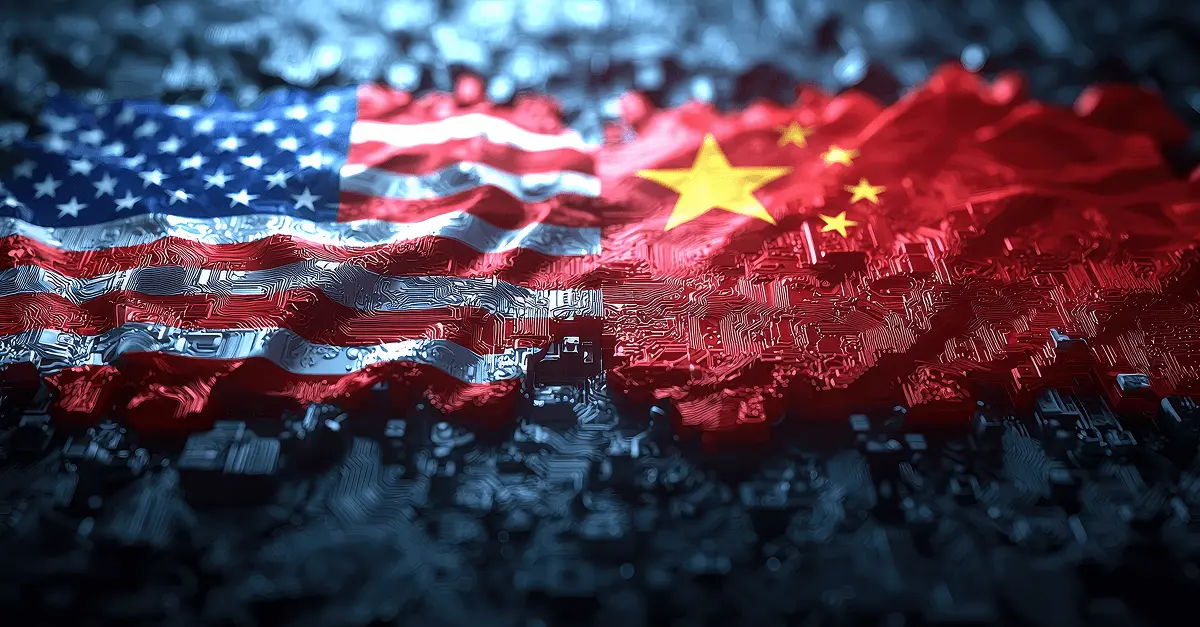Inside the U.S. Government’s Bold Revenue-Sharing Deal With Chipmakers Nvidia & AMD
The U.S. government recently announced plans to take a cut of China-related revenue for two major American chip firms. Our primer, below, answers key questions.

Article Highlights:
- In exchange for export licenses allowing Nvidia and AMD the right to sell specific artificial intelligence chips to China, the firms agreed to pay the Commerce Department 15% of their revenue from those sales.
- To understand how consequential the agreement reached between Nvidia, AMD, and the U.S. government is, it’s important to assess the larger context of the technological conflict between the U.S. and China, including the various export restrictions on China the U.S. has implemented over the past five years.
- In the days since the deal was announced, legal experts have been explicit in pointing out the agreement’s legal murkiness. Article I, Section 9 of the U.S. Constitution says, “No Tax or Duty shall be laid on Articles exported from any State”—a section generally referred to as the Export Clause.
What’s in the AI Chips Deal? Key Terms and Triggers
On Sunday, August 10, various outlets began reporting that two major U.S. semiconductor manufacturers, Nvidia and Advanced Micron Devices (AMD), had struck an unprecedented deal with the federal government. In exchange for export licenses allowing Nvidia and AMD the right to sell specific artificial intelligence chips to China, the firms agreed to pay the Commerce Department 15% of their revenue from those sales.
Nvidia will be permitted to sell an AI chip called the H20 to Chinese customers, while AMD will be granted an export license for its MI308, another AI chip.
According to reporting by The New York Times, Nvidia CEO Jensen Huang met with President Trump on Wednesday, August 6, during which the chipmaker’s revenue-sharing agreement was struck. While the timeline for AMD’s revenue-sharing deal has not been reported on as comprehensively, the Santa Clara-based chip firm ultimately reached the same framework agreement.
During a press conference on August 11, President Trump confirmed the arrangement and described the path to reaching a deal, noting that he was originally looking for a 20% cut of Nvidia’s AI chip sales to China. Huang, however, was able to get the president to agree to 15%. “So we negotiated a little deal. So he’s selling a essentially old chip,” Trump said. In statements to the media following the deal’s announcement, Nvidia emphasized that they were only following the guidelines laid out for them by the federal government. “We follow rules the U.S. government sets for our participation in worldwide markets,” Nvidia wrote, in a statement to the Associated Press. “While we haven’t shipped H20 to China for months, we hope export control rules will let America compete in China and worldwide.”
A Brief History of the U.S.-China Chips War
To understand how consequential the agreement reached between Nvidia, AMD, and the U.S. government is, it’s important to assess the larger context of the technological conflict between the U.S. and China. America has been implementing policies aimed at hamstringing China’s technological advancements since as early as May 2020, when the U.S. Commerce Department announced that it was banning companies that utilize American technology from designing or manufacturing semiconductors for Huawei, one of China’s largest and most successful technology companies. Since then, the U.S. government has enacted a succession of controls on exports to China.
Timeline of U.S. Export License Restrictions on China
- May 2020: The U.S. Commerce Department announces a ban on companies using American technology from designing or producing semiconductors for Huawei. Within days, TSMC adhered to the directive, and stopped taking orders from Huawei. By 2023, the Chinese telecommunications giant’s profits had plummeted by nearly 70%.
- October 2022: The U.S. Bureau of Industry (BIS) and Security implemented export controls on China, restricting U.S. manufacturers from sending chips, semiconductor manufacturing equipment (SME), and a myriad of other related technologies.
- October 2023: BIS expands the export control regime established the prior year, broadening the list of restricted goods and adding 13 Chinese companies to the Entity List. “The PRC government is attempting to divert a lot of civilian technologies, particularly in computing, space, AI and communications, into areas of supercomputers in civil-military fusion programs as well as other areas such as surveillance that link with human rights abuses,” a Department of Commerce official explained at the time of the restrictions’ implementation.
The Trump administration’s revenue-sharing deal with Nvidia and AMD is notable because of how much of a departure it represents from the U.S. government’s recent efforts to hamper China’s technological progress. Part of these efforts have been centered around preventing the nation from carrying out the “civil-military fusion” doctrine that many believe is core to its goal of surpassing the U.S. as a superpower. Trump’s approach, contrastingly, may be perceived as less strategic and more transactional: as long as the U.S. is profiting from commercial activity between the two nations, then giving China the hardware to power AI technology is permissible.
The Trump administration’s revenue-sharing deal with Nvidia and AMD is notable because of how much of a departure it represents from the U.S. government’s recent efforts to hamper China’s technological progress.
Financial Impacts of AI Chips’ Export License
The financial implications of the revenue-sharing agreement are significant, with both Nvidia and AMD committing significant future earnings to U.S. government coffers.
- Nvidia: In 2024, the chip design firm grossed around $18 billion in revenue from China. Using that number as a guide, Nvidia could be paying the Commerce Department as much as $2.7 billion a year for the right to access the Chinese market.
- AMD: A significantly smaller company than Nvidia, with annual revenue just under $26 billion in 2024, AMD reportedly sells about $800 million worth of chips to China every year. This would mean that the manufacturer would be diverting about $120 million to the U.S. government annually.
- U.S. Commerce Department: The agreement could net the U.S. Department of Commerce between $2 and $3 billion a year, depending on the AI chip sales to China for Nvidia and AMD. While this may sound like a substantial sum, it pales in comparison to what the Trump administration is currently netting from its broader tariff regime. In each of May, June, and July, the U.S. government has collected over $25 billion from tariffs. If this is the beginning of a larger revenue-sharing policy, however, those relatively modest figures could climb rapidly.
While most analysts who’ve weighed in on the deal appear to feel that it’s worthwhile for the U.S. chipmakers, that doesn’t mean they won’t feel a squeeze from the revenue-sharing arrangement. Nvidia is poised to lose between 8% and 10% of its gross margins in the Chinese market, with AMD’s margins dropping off by a more modest 5% or so.
Is the Nvidia and AMD Revenue-Sharing Agreement Illegal?
Although the deal has only been public for a week or so, it’s already ignited heated debate about the legality of the Trump administration’s bold maneuvering with two of its largest domestic semiconductor firms.
- Peter Harrell, a White House staffer focused on international economics under the Biden administration, asserted the deal’s unconstitutionality shortly after it was announced. “In addition to the policy problems with just charging Nvidia and AMD a 15% share of revenues to sell advanced chips in China, the U.S. Constitution flatly forbids export taxes,” he said in a social media post on Sunday, August 10.
- Christopher Padilla, an export control official with the George W. Bush administration, characterized the deal to the Washington Post as “unprecedented and dangerous.” He went on to explain that “export controls are in place to protect national security, not raise revenue for the government.”
In the days since the deal was announced, legal experts have been even more explicit in pointing out the agreement’s legal murkiness. Article I, Section 9 of the U.S. Constitution says, “No Tax or Duty shall be laid on Articles exported from any State”—a section generally referred to as the Export Clause. More recent laws also cast the move in doubt. The Export Control Reform Act of 2018 appears to explicitly prohibit fees associated with export licenses. 50 U.S.C. § 4815(c) states, “No fee may be charged in connection with the submission, processing, or consideration of any application for a license or other authorization or other request made in connection with any regulation in effect under the authority of this subchapter.”
Officials from the Trump administration have conceded that they’re still working through the legal challenges associated with finalizing an unusual and controversial agreement. On August 14, White House press secretary Karoline Leavitt noted that the Commerce Department continued to focus on getting the deal through various hurdles. “The legality of it, the mechanics of it, is still being ironed out by the Department of Commerce, and I would defer you to them for any further details on how it will actually be implemented,” she said.
Officials from the Trump administration have conceded that they’re still working through the legal challenges associated with finalizing an unusual and controversial agreement.
Supply Chain Risk Management Helps With Shifting Supply Chains
While still not finalized, the revenue-sharing deal between Nvidia, AMD, and the U.S. government could be a sign of things to come for American businesses, and their exports more specifically. Given the uncertainty and dynamism the Trump administration has introduced into both domestic and international supply chains, organizations need to be able to rely more than ever on agility and proactive risk management.
Supply chain risk management (SCRM) platform Z2Data combines supply chain visibility, risk assessment, sub-tier intelligence, and other capabilities into an all-encompassing tool for identifying and mitigating risk in your supply chain. Z2Data’s SCRM solution allows businesses to draw on a range of features to help them strengthen resilience across their manufacturing networks:
- Supply Chain Mapping
- Sub-Tier Intelligence
- Out-of-the-Box Risk Assessments
- Real-Time Risk Monitoring
- Event Detection and Impact Analysis
- AI-powered Event Assessments
To learn more about Z2Data and how its solutions can help companies expertly navigate today’s volatile supply chain risk landscape, schedule a free trial with one of our product experts.
The Z2Data Solution
Z2Data is a leading supply chain risk management platform that helps organizations identify supply chain risks, build operational resilience, and preserve product continuity.
Powered by a proprietary database of 1B+ components, 1M+ suppliers, and 200K manufacturing sites worldwide, Z2Data delivers real-time, multi-tier visibility into obsolescence/EOL, ESG & trade compliance, geopolitics, and supplier health. It does this by combining human expertise with AI and machine learning capabilities to provide trusted insights teams can act on to tackle threats at every stage of the product lifecycle.
With Z2Data, organizations gain the knowledge they need to act decisively and navigate supply chain challenges with confidence.


.svg)






